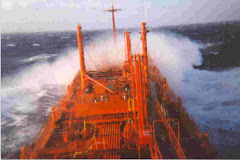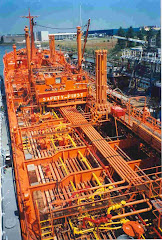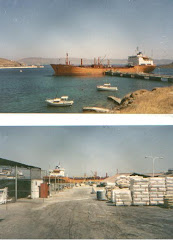This year has seen considerable new investment in large block speculative shipping deals. Peter Georgiopoulos did a US$ 886 mio deal in May to buyout the Metrostar fleet, and now a US$ 545 mio deal for 16 bulkers from Bourbon. Metrostar paid a record price of US$ 180 mio for five container vessels. The driver is anticipated economic recovery driven by Chinese export growth. Good times again as if the 2008 meltdown never happened. Yet already there are signs of a slowdown. Will China save the day?
Global growth since the 1980's has depended increasingly on monetary easing to induce asset inflation for stimulus, each dose of monetary stimulus resulting gradually in weaker recoveries with increasing joblessness. Wages in Western countries have remained fairly static and the government authorities have encouraged consumer lending to prime consumer spending with households becoming increasingly indebted. As an example, much of the growth in the US since the Dot.com meltdown of 2000 was due to easy money that fueled a real estate bubble and led to the subprime mortgage crisis and massive foreclosures. The housing market in the US remains moribund.
The Asian emerging market countries since their financial crisis in the late 1990's moved to a neo-mercantilism whereby they kept their currencies undervalued to generate large trade surpluses through aggressive export policies. They recycle the money into developed western countries keeping down their exchange rates and financing their trade partners' deficits. One of Ben Bernanke's major speeches a few years before he become FED chairman was characteristically entitled "The Global Saving Glut and the U.S. Current Account Deficit" as a sign the times.
Eerily reminiscent of the defunct Dot.com investment craze, China has become the rage with investors as an eldorado of unlimited growth potential. This optimism fueled interest for shipping issues on Wall Street, especially for dry cargo vessels to transport iron ore and coal for the steel production with the increased demand created by the real estate boom in coastal areas. Likewise investors went wild over the container sector where the only concerns of Seaspan (SSW) CEO Jerry Wang were whether Los Angeles could expand its port facilities to cope with the insatiable demand for Chinese goods.
Since the 2008 meltdown, there has been a modest recovery in both the US and EU but there remains a huge sovereign, corporate and household debt overhang in a balance sheet style recession. The most robust growth has been in emerging markets where there are much lower sovereign debt levels. The Chinese could finance their stimulus out of their trade surpluses, but there is growing evidence that the stimulus money has resulted in commodities inventory stocking as well as an over-heated housing market that is causing a serious real estate bubble.
Growth in the US seems to be slowing now that we are moving to the second half of the year. The EU has been confronted with serious sovereign debt problems in their weaker members of which Greece is now under a joint IMF-EU workout. Bad management of the Greek crisis and serious structural deficiencies in the Euro system resulted in contagion in other member countries, which led to a massive emergency EU bailout facility funded by member states and IMF participation. The ECB balance sheet is filled with toxic EU government securities. It even suspended minimal ratings standards for Greece. The weaker PIIGS members are all under strict austerity programs. The UK, whilst in a somewhat better position free of the Euro albatross, has also voluntarily started an austerity program to address its fiscal and debt problems.
In this environment, Chinese capital surpluses are becoming harder to export. The weaker EU members were the second largest importer of these surpluses, but now austerity programs make this unsustainable. There is is already evidence of falling trade volume on western bound container trade lanes from the Far East. Meanwhile dry cargo freights as represented by the BDI have plummeted to levels not seen since the fall of 2008. The dry cargo pundits feel that the drop in dry bulk rates is only temporary due to Chinese contract renewal negotiations with producers. Likewise, container operators like Maersk, euphoric over recent transpacific rate increases, are projecting a surge in profits that match 2008 levels. External signs, however, are troubling.
What we see is that China has an increasingly volatile economy with large swings. The real estate is showing signs of decline. Non-performing loans are on the rise. Dependence on the US to export trade surpluses has risen since EU sovereign debt problems and austerity programs. The next tension is likely to be between the US and China on trade surpluses, especially if US unemployment remains at present levels. The last thing that China wants is to import the surpluses domestically because this would lead to currency appreciation and risk bankrupting the exporting companies.
All hopes at present are on another Chinese stimulus program to shore up the output gap. There appears a growing internal debate on how to manage their housing bubble and overheated economy, but the other major issue is the sustainability of the export model and how to deal with the shock from the EU and US taking measures to address defensively their large unemployment problems in a time span that is out of their control.
As FT's Walter Munchau put it:
The pessimists believe that a strong global recovery is unlikely given the persistence of financial stress, and the deleveraging of the private and public sectors across the industrialized world.
The optimists divide into two groups. There are those who have difficulties counting to zero, who cannot add up the global private, public, and foreign balances, which must equal zero by definition.
And then there are the rational optimists, whose expectations of resurgence in private sector demand must surely rest on the assumption of a return to even greater global imbalances than before the crisis, to which the eurozone will this time contribute actively. But this is surely not a sustainable position.
The pessimists would argue that global demand growth will not be sufficiently strong to support a selfsustained recovery in the eurozone. Even the rational optimists, who believe that this is possible, would probably conclude that these imbalances are not sustainable, and may trigger another financial crisis down the road. And if that is what you expect, you are not really an optimist.
What we know is that some of our societies are deeply over-leveraged, and that de-leveraging them means running trade surpluses, not deficits. That is not good for China nor the 'smart money' in shipping!
A prolonged, sluggish global recovery with high levels of unemployment in Western consumer economies and possibly a series of sovereign defaults of which the restructuring of the Greek public debt is high on the agenda would lead to renewed stress on the banking system, particularly in Europe. Overleveraged companies having already negotiated covenant extensions with their banks may be forced to sell assets at distressed prices that everyone has been trying to avoid the last few years.
We see a lot of 'smart money' in shipping assets. The new IPO's earlier this year like Baltic (BALT), Crude Carriers (CRU) and Scorpio (STNG) are all trading at discounts. Albeit these companies have bought marked down assets and have low leverage, it is unlikely there will be appetite for further issues unless the discount is closed. It will be interesting to see what levels, Genco (GNK) obtains in raising equity and debt funding to close the 16-vessel Bourbon deal. Generally, Wall Street remains soft and shipping issues have generally never recovered to pre-2008 levels. Many of them are trading below US$ 10.








